Pain Diagnosis
At the stage of pain diagnosis, your pain management physicians need to find the cause of your pain, here our certified doctor will review your past medical history and perform a physical examination.
At the stage of pain diagnosis, your pain management physicians need to find the cause of your pain, here our certified doctor will review your past medical history and perform a physical examination.

Overview
A herniated disc is a common injury that can affect any part of the spine. A herniated disc can cause severe pain and other problems in the arms or legs.
Disc Anatomy
Vertebral discs are flexible, rubbery cushions that support the vertebral bones. They allow the spine to twist and bend. Each disc has a soft inner nucleus that is surrounded by a fibrous outer wall.
Herniated Disc
A herniated disc occurs when the nucleus pushes through the outer wall. This herniation can result in a large bulge that can press against nearby nerve roots.
Causes
Herniated discs commonly result from age-related weakening of the spinal discs. This is called disc degeneration, and it can occur gradually over many years as a result of normal wear and tear on the spine.
A herniated disc can also result from a traumatic injury, or from lifting a heavy object improperly.
Symptoms
Symptoms of a herniated disc vary depending on the location of the disc and the severity of the rupture. Some herniated discs cause no symptoms, and a person with this type of injury may not realize the disc is damaged. But a herniated disc can also cause severe pain, numbness or tingling, and weakness.
Most herniated discs occur in the lower back, where they can cause symptoms in the buttocks, legs and feet. Herniated discs also occur in the neck, where they can cause symptoms in the shoulders, arms and hands.
Treatment
Treatment options for herniated disc depend on the location and severity of the injury.
A herniated disc may be treated with pain-relieving medications, muscle relaxers and corticosteroid injections. A person with a herniated disc may benefit from physical therapy. If these methods are not effective, the disc may need to be treated with a surgical procedure.
Cervical facet syndrome, also known as cervical facet disease or cervical osteoarthritis, is the structural deterioration of one or more of the vertebral facet joints in the cervical (upper) segment of the spine, which is mostly located in the neck.
Whiplash, also called cervical acceleration / deceleration (or CAD) syndrome, is a neck injury commonly caused by car accidents, falls, and contact sports. It results from a quick, jerking motion that forces the neck beyond its normal range of motion.
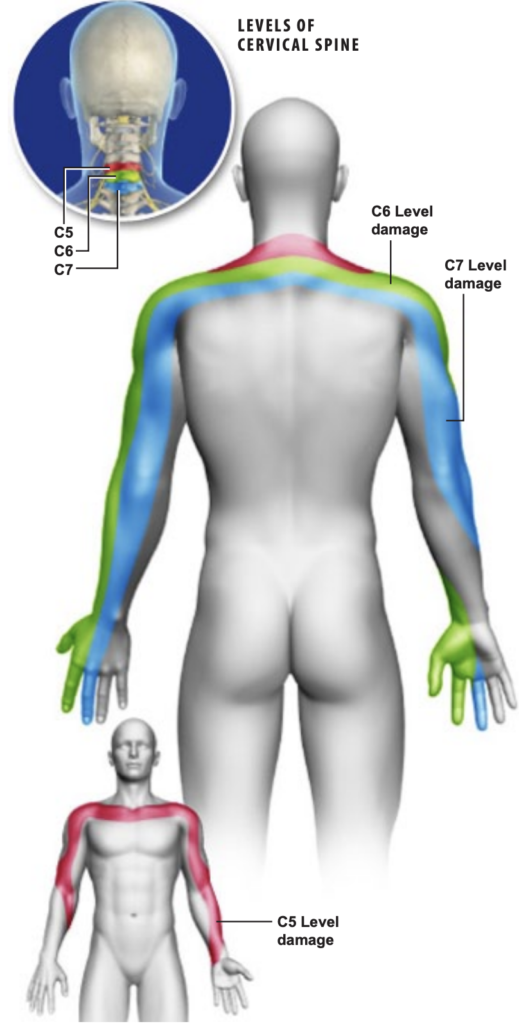
Overview
This condition is an irritation or compression of one or more nerve roots in the cervical spine. Because these nerves travel to the shoulders, arms and hands, an injury in the cervical spine can cause symptoms in these areas. Cervical radiculopathy may result from a variety of problems with the bones and tissues of the cervical spinal column.
Causes (Herniated Disc)
One common cause is a herniated disc. A herniated disc is a rupture in the fibrous outer wall of a vertebral disc, which allows the soft nucleus of the disc to bulge outward. This bulge can press harmfully against a nerve root.
Causes (Degenerative Disc Disease)
Another common cause of nerve root injury is degenerative disc disease. It occurs when a spinal disc weakens, allowing vertebral bones above and below the disc to shift out of position. The bones can touch, pinching nearby nerve roots.
Causes (Spinal Stenosis)
When bones, discs or joints of the spine degenerate, bony spurs may form and push into the spinal canal or foramen space. This is called spinal stenosis, and it can also create harmful pressure against the spinal cord or nerve roots.
Symptoms
Nerve root injury in the cervical spine most commonly involves one of the three lowest levels of cervical vertebrae, which are called C5, C6 and C7. Symptoms may include pain, weakness, numbness and tingling, and may vary depending on the level of the injury. For example, an injury at the C5 level may cause pain and weakness in the shoulder and upper arm.
An injury at the next vertebral level (the C6 vertebrae) may cause pain in the shoulder and the arm, and it may also cause weakness in the arm. And finally, an injury at the lowest level (the C7 vertebrae) may cause pain from the neck all the way down to the hand, along with weakness in the arm and hand.
In serious cases, a thoracic herniated disc can lead to paralysis from the waist down. Lateral disc herniation. When herniating laterally, or to the side, the thoracic herniated disc is more likely to impinge on the exiting nerve root at that level of the spine and cause radiating chest wall or abdominal pain.
Scoliosis occurs most often during the growth spurt just before puberty. Most cases are mild with few symptoms. Some children develop spine deformities that get more severe as they grow. Severe scoliosis can be painful and disabling. Often, no treatment is necessary. Sometimes a brace or surgery is needed.
A herniated disc of the Lumbar is a common injury that can affect any part of the spine. A herniated disc can cause severe pain and other problems in the arms or legs.
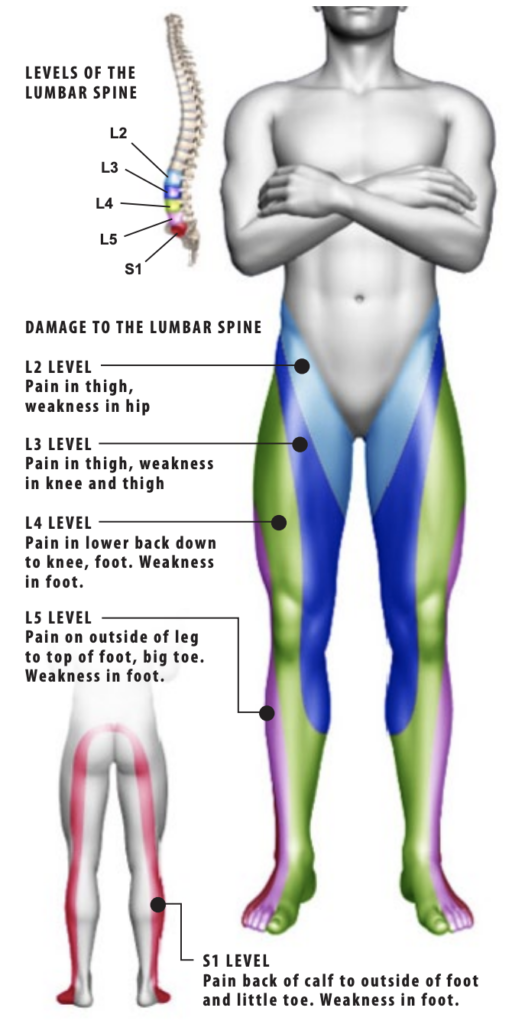
Overview
This condition is an irritation or compression of one or more nerve roots in the lumbar spine. Because these nerves travel to the hips, buttocks, legs and feet, an injury in the lumbar spine can cause symptoms in these areas. Sciatica may result from a variety of problems with the bones and tissues of the lumbar spinal column.
Causes (Herniated Disc)
One common cause is a herniated disc. A herniated disc is a rupture in the fibrous outer wall of a vertebral disc, which allows the soft nucleus of the disc to bulge outward. This bulge can press harmfully against a nerve root.
Causes (Degenerative Disc Disease)
Another common cause of nerve root injury is degenerative disc disease. It occurs when a spinal disc weakens, allowing vertebral bones above and below the disc to shift out of position. The bones can touch, pinching nearby nerve roots.
Causes (Spinal Stenosis)
When bones, discs or joints of the spine degenerate, bony spurs may form and push into the spinal canal or foramen space. This is called spinal stenosis, and it can also create harmful pressure against the nerve roots.
Symptoms
Nerve root injury may occur at any of the five vertebrae in the lumbar spine (called the L1 through L5), or at the level of the sacrum (the upper portion of which is called the S1). Symptoms may include pain, weakness, numbness and tingling, and may vary depending on the level of the injury. For example, an injury at the L2 level can create thigh pain and hip weakness. An injury at the L3 level may result in thigh pain and knee and thigh weakness. Damage at the L4 level may cause pain from the lower back to the foot and also foot weakness. Damage at the L5 level can create pain from the outer leg to the top of the foot and also foot weakness. And finally, damage at the S1 level can create pain from the calf to the outer foot and also foot weakness.
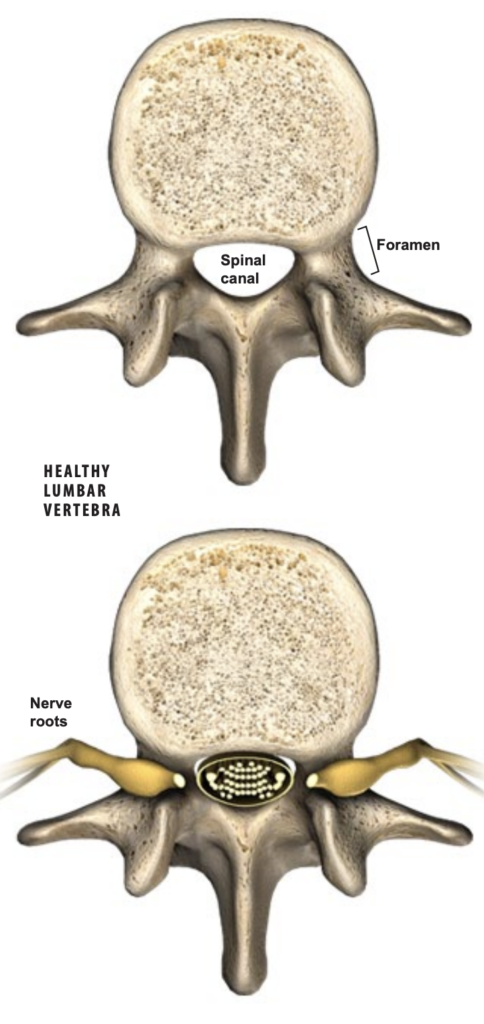 Overview
Overview
The spinal column contains open spaces that create passageways for the spinal cord and the spinal nerves. Spinal stenosis is a narrowing of (or an intrusion into) these openings. This can cause a compression of the nerves. Spinal stenosis most commonly affects the cervical and lumbar regions of the spine.
Anatomy
Each vertebra has a large opening at the rear called the spinal canal. In the cervical and thoracic regions of the spine, the spinal cord travels through this space. In the lumbar region of the spine, this opening contains a bundle of nerve roots. Openings called foramina branch away from the spinal canal. These spaces provide pathways for the nerve roots that travel from the spine to other parts of the body.
Stenosis
In a spine with stenosis, one or more of these openings are narrowed. The spinal nerves can become compressed against the vertebral bone. This can interfere with nerve function. It can cause pain in the spine or in other parts of the body.
Causes
Stenosis is commonly caused by an excess growth of bone around the spinal nerves. This excess bone growth often results from osteoarthritis. Stenosis can also result from a dislocation or a fracture of the vertebral bone. Stenosis can be caused by soft tissue intruding into the spine’s open spaces. Herniated discs, tumors, and thickened spinal ligaments can press against the spinal nerves. And in some cases, a person is born with a small spinal canal that does not provide enough room for the spinal nerves.
Symptoms
Symptoms of spinal stenosis can vary depending on the location and severity of the problem. Spinal stenosis can cause pain, weakness, numbness and tingling in the arms and legs. Spinal stenosis in the lower back commonly causes sciatica, a sensation of burning pain that can travel through the buttocks and down the legs. Spinal stenosis can also cause problems with control of the bladder and bowels.
Treatment
Treatment options for spinal stenosis may include anti-inflammatory medications, muscle relaxants and medications to relieve pain. Steroid injections may be beneficial. A physician may also recommend physical therapy. If these methods are not effective, surgery may be needed to eliminate pressure on the nerves.
This type of fracture is a collapse of the vertebral bone that can affect one or more vertebra. It can result in a severe deformity of the spinal column. Compression fractures may affect any of the vertebrae, but most commonly occur in the lower thoracic and upper lumbar regions.
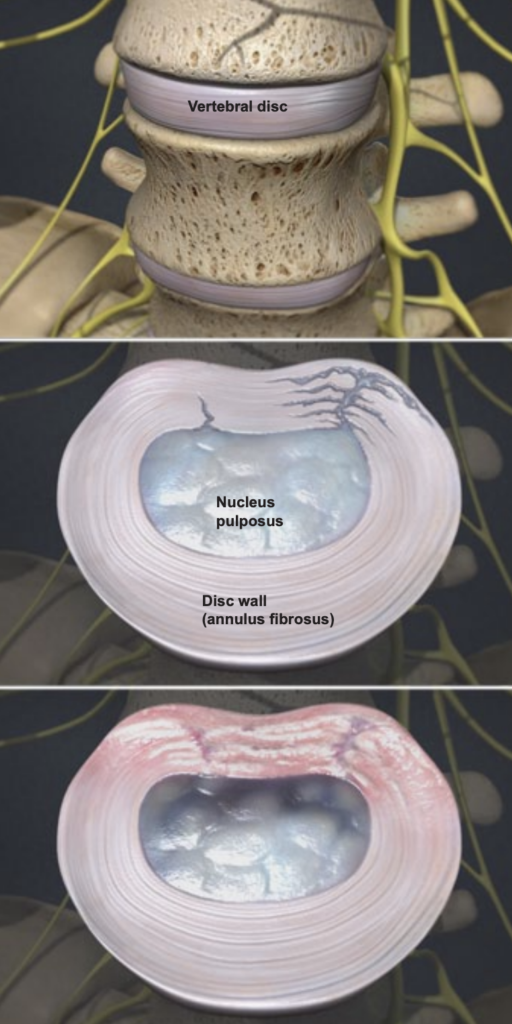 Overview
Overview
This condition is a weakening of one or more vertebral discs, which normally act as a cushion between the vertebrae. This condition can develop as a natural part of the aging process, but it may also result from injury to the back.
Disc Wall Tears
Degenerative disc disease typically begins when small tears appear in the disc wall, called the annulus. These tears can cause pain.
Disc Wall Heals
When the tears heal, creating scar tissue that is not as strong as the original disc wall. If the back is repeatedly injured, the process of tearing and scarring may continue, weakening the disc wall.
Disc Center Weakens
Over time, the nucleus (or center) of the disc becomes damaged and loses some of its water content. This center is called the pulposus, and its water content is needed to keep the disc functioning as a shock absorber for the spine.
Nucleus Collapses
Unable to act as a cushion, the nucleus collapses. The vertebrae above and below this damaged disc slide closer together. This improper alignment causes the facet joints – the areas where the vertebral bones touch – to twist into an unnatural position.
Bone Spurs Form
In time, this awkward positioning of the vertebrae may create bone spurs. If these spurs grow into the spinal canal, they may pinch the spinal cord and nerves (a condition called spinal stenosis). The site of the injury may be painful.
Symptoms
Some people experience pain, numbness or tingling in the legs. Strong pain tends to come and go. Bending, twisting and sitting may make the pain worse. Lying down relieves pressure on the spine.
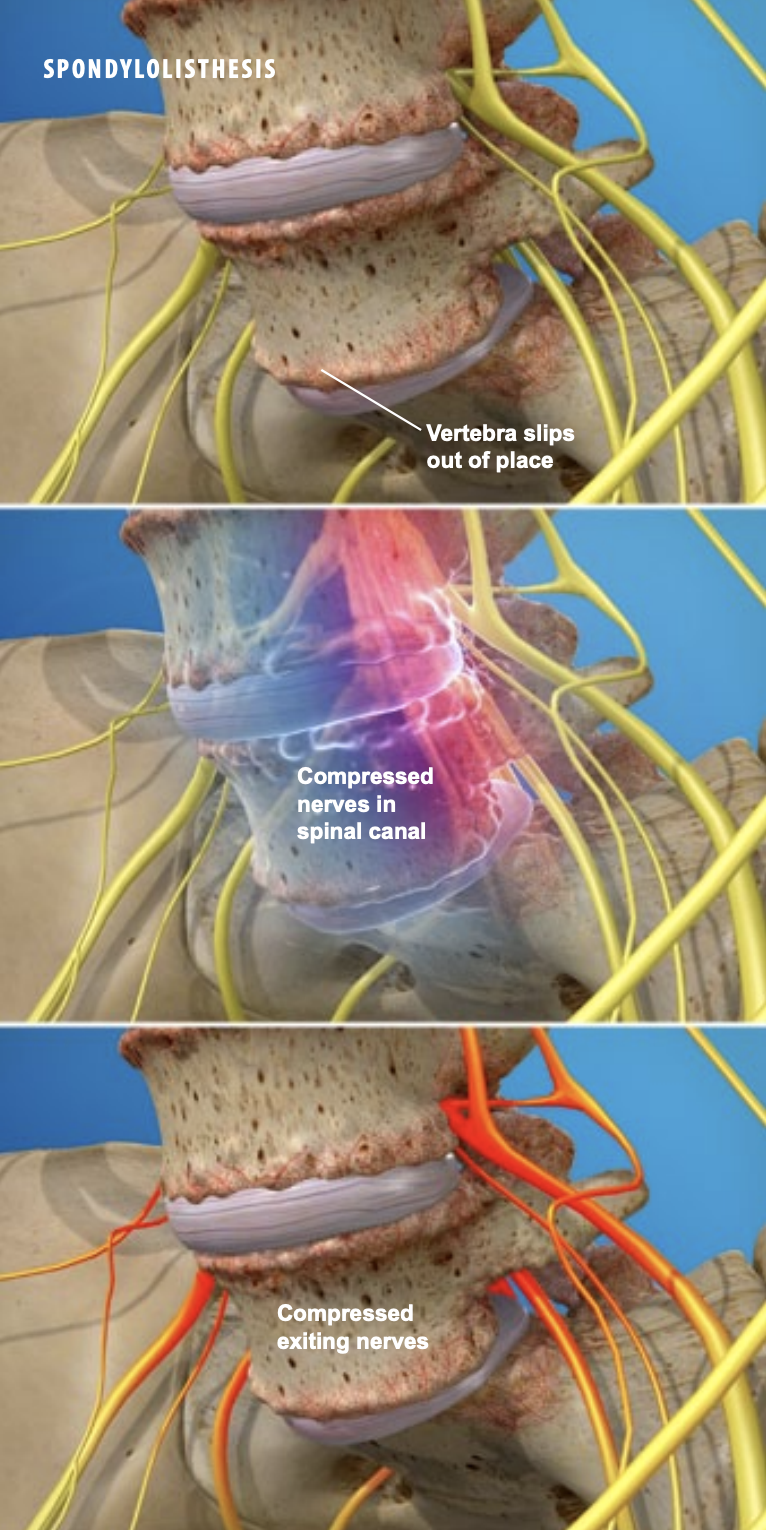 Overview
Overview
This condition occurs when a lumbar vertebra slips out of place. It slides forward, distorting the shape of your spine. This may compress the nerves in the spinal canal. The nerves that exit the foramen (open spaces on the sides of your vertebrae) may also be compressed. These compressed nerves can cause pain and other problems.
Common Causes
Spondylolisthesis has a variety of causes. In children, it is often due to a birth defect in that area of the spine. Some people develop this condition because of an overuse injury called “spondylolysis.” This is a stress fracture of the vertebral bone. In adults, arthritis and the loss of disc elasticity that results from aging are the most common causes of spondylolisthesis.
Other Causes
Less commonly, spondylolisthesis can result from a sudden injury that leads to a broken vertebra. Diseases or tumors that weaken the spine can also result in spondylolisthesis.
Symptoms
Symptoms vary from person to person. Many people who have this condition have no symptoms at all. If you do have symptoms, you may experience pain in your lower back. You may have hamstring spasms. Pain may spread down your leg to your foot. You may also have foot numbness and tingling.
Treatment
Treatment options depend on the severity of your condition. You may benefit from rest. Medications may relieve your pain. A back brace may also help. And, you may benefit from physical therapy. If those methods are not successful, you may benefit from a surgical procedure to reduce nerve compression or to stabilize your spine.
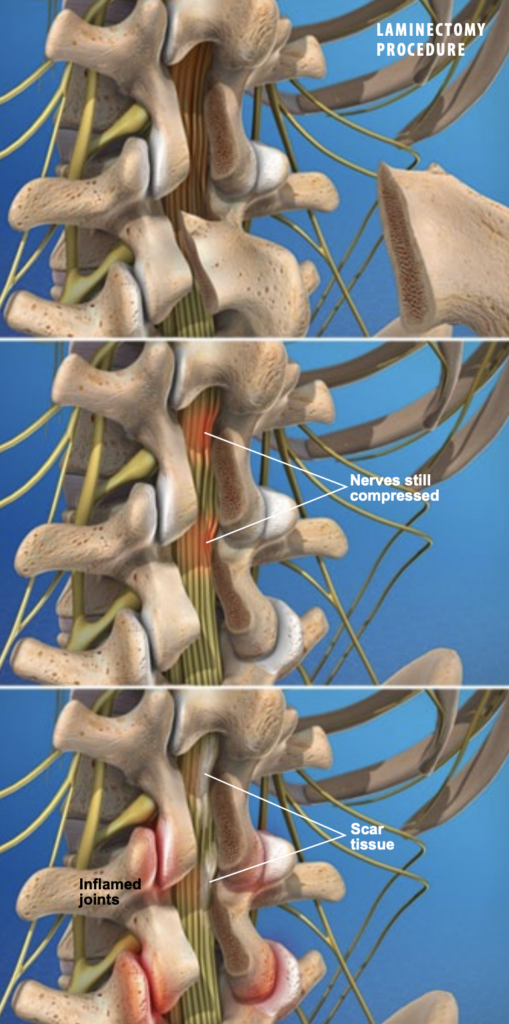 Overview
Overview
This condition, also called “failed back syndrome,” is a type of chronic pain. It can develop in some people after spine surgery.
Causes
This pain most often develops after a laminectomy procedure. This is the removal of bone at the rear of your vertebrae. The procedure is done to relieve pressure on your spinal nerves. But after a laminectomy, bone or soft tissue may still press on these nerves. Scar tissue may form. And spinal joints may be irritated and inflamed. Pain from any of these issues may be called “post-laminectomy syndrome.”
Symptoms
Symptoms may include pain in your back at the site of your surgery. The pain may also radiate down to your buttock and leg. This pain may feel sharp, or it may feel dull and achy.
Treatment
Treatment depends on the cause and the severity of your pain. It may include medications, injections or physical therapy. You may benefit from electrical nerve stimulation or other techniques. If these are not helpful, surgery may relieve your pain.